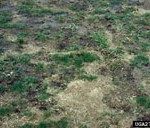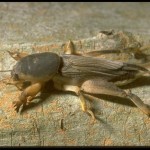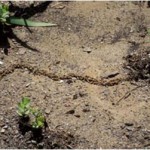Mole cricket problems in Texas are highly localized, but can be persistent over time. The southern mole cricket is found along the Texas coast westward to College Station and north to Longview. This species preys on other turf pests. Unfortunately, in searching for its prey it disrupts turf by tunneling just under the soil surface. A mole cricket can tunnel several meters per day. Bermudagrass and bahiagrass, particularly in areas with sandy soil, are more affected than is St. Augustinegrass. One proposed action level for initiating treatment is two crickets per square foot as determined using the soapy water drench method. More at Texas A&M AgriLife Extension Publication EEE-00039.
Description
Mole crickets have front legs enlarged, shovel-like and modified for digging. Adults are cylindrical, nearly 1-1/2 inches long and dull brown. The shield-like segment just behind the head (pronotum) is marked with two pairs of pale spots. There are two finger-like projections (dactyls) on the terminal segment of the front leg (tibiae) separated by a u-shaped gap, and the hind tibiae is longer than the pronotum. Adults have well-developed wings covering 3/4 of the abdomen when held at rest. They fly at night, can run quickly, but are poor jumpers.Nymphs resemble adults but are smaller and do not have fully developed wings.
Life Cycle
Simple metamorphosis (egg, nymph, adult). Winter is spent as partially grown nymphs and as adults. In spring and early summer, mating and dispersal flights occur and afterwards females lay eggs in cells dug in the soil. Eggs hatch in about 2 weeks and nymphs develop through eight stages (instars) during the summer months. One generation is produced per year, although a second generation may occur in southern Texas.
Habitat, Food Source(s), Damage

Mole cricket damage to turfgrass. Photo courtesy of University of Georgia, Bugwood.org
Mole crickets are soil insects. Southern mole crickets are prey on other soil organisms in turfgrass, vegetable gardens, ornamental beds and other environments, whereas the tawny mole cricket is a plant feeder and feed at or slightly below the soil surface on roots, tubers and stems. Infestations are usually very spotty and localized. Mole crickets prefer sandy soil and are often found in golf courses and live in 1/2 inch diameter burrows. They are active at night and either tunnel just beneath the surface up to 20 feet per night when soil is moist in search of insect prey or come to the surface and run about freely.
Tunneling activities can be very disruptive to many plants. They loosen the soil around the root system, causing the roots to dry out. Bermudagrass and bahiagrass, particularly in areas with sandy soil, are often more affected than St. Augustinegrass. Reduction of plant stand is common. The small mounds and tunnels or ridges of soil are a particular problem on golf course putting greens.
Pest Status
The southern mole cricket feeds primarily on other insects and earthworms as nymphs and adults; their prey-searching activities involving digging shallow tunnels in soil, resembling mole runs, which disrupt root systems of turfgrass and crops. The southern mole cricket occurs in the eastern one-third of the state, having spread westward after being accidentally introduced into Galveston and other southeastern locations form South America around 1900. Life stages are not medically harmful to man and animals.


